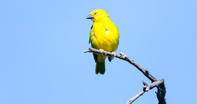
Name
Golden weaver (Ploceus xanthops). The alternate name is a Holub’s weaver.Appearance
The golden weaver is a large weaver, at 17 cm in length, with a heavy black bill, a pale yellow eye, yellow underparts and head, and a chestnut brown face wash. The male has the chestnut brown wash extending down on to the chest.The female golden weaver is similar to the male, but is duller than the male.
Diet
The golden weaver is omnivorous and feeds on insects, seeds, fruit and nectar.Golden Weaver Breeding
The golden weaver is monogamous and semi-colonial. The male golden weaver is very territorial. Two or three males will have adjoining territories that make up the loose colony.The female golden weaver will lay between one and three eggs, incubation takes around 14 days. Both parents feed the chicks and they fledge after 19 to 22 days.
The golden weaver is parasitised by the Diederik cuckoo.